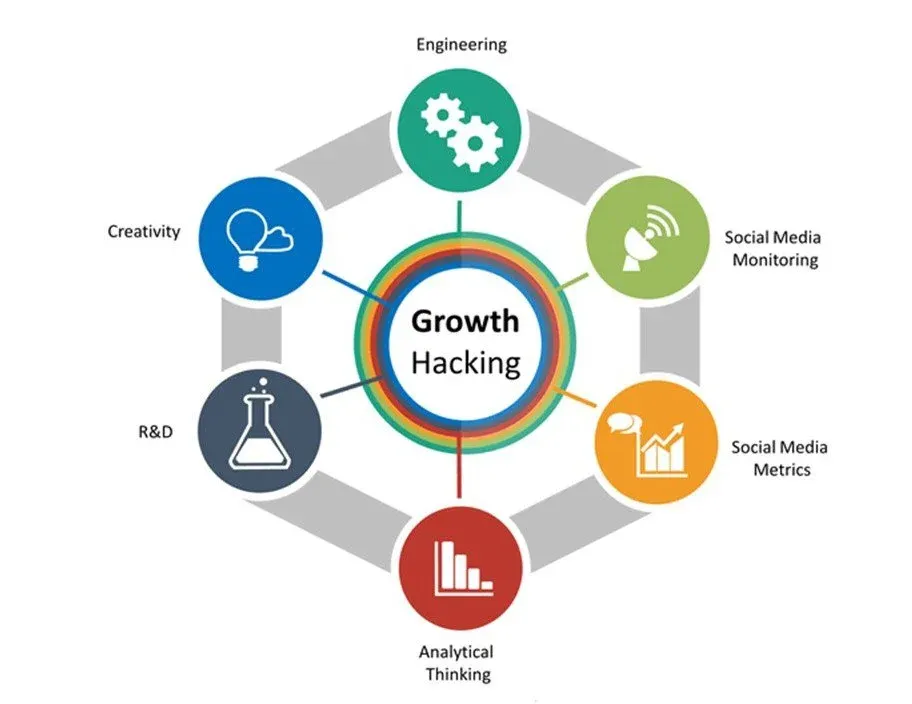Mastering the Art of Growth Hacking: Innovative Techniques for Business Expansion
Understand growth hacking & its strategies. Discover innovative techniques for business expansion & master the art of exponential growth.
Welcome to the exciting world of growth hacking!
In today's rapidly evolving business landscape, traditional marketing techniques are no longer enough to drive sustainable growth and success.
Enter growth hacking – a strategy that combines creativity, data-driven decision making, and innovative techniques to propel businesses to new heights.
In this article, we will explore the art of growth hacking and uncover the strategies and tactics that can help businesses expand and thrive in a highly competitive digital era.
Whether you're a startup founder, an entrepreneur, or a marketing professional, mastering the art of growth hacking is essential for staying ahead of the curve and achieving remarkable business growth.
So, buckle up and get ready to dive deep into the world of growth hacking. We'll cover everything from understanding growth hacking and identifying opportunities to customer acquisition strategies, product optimization, data-driven decision making, scaling and expansion, measuring success, and ethical considerations.
Let's get started!

Understanding Growth Hacking
Welcome to the exciting world of growth hacking!
In this section, we will explore what growth hacking is all about and how it differs from traditional marketing strategies. So, let's dive in!
Definition and Concept
Growth hacking is a mindset, a set of techniques, and a data-driven approach to achieving rapid growth for a business or startup. It focuses on finding innovative and unconventional ways to attract, engage, and retain customers.
Unlike traditional marketing, growth hacking is not limited to a specific department or function. It involves cross-functional collaboration and requires a blend of creativity, analytical thinking, and technical skills.
Growth hackers are like modern-day alchemists. They experiment with various marketing channels, product optimizations, and customer acquisition strategies to unlock the secrets of exponential growth.
Rather than relying on big budgets, growth hacking revolves around leveraging limited resources efficiently and effectively.
Differentiating Growth Hacking from Traditional Marketing
While growth hacking and traditional marketing share some common goals, there are key differences between the two approaches:
- Traditional Marketing:
Traditional marketing focuses on creating brand awareness, attracting leads, and increasing sales through strategies such as TV and radio ads, print media, and billboards. It often involves a more top-down approach and relies on big marketing budgets. - Growth Hacking:
Growth hacking, on the other hand, is a more iterative and data-driven approach. It focuses on rapid experimentation, scalable marketing tactics, and product optimization to achieve exponential growth. Growth hackers prioritize measurable results and are constantly testing and refining their strategies.
In summary, while traditional marketing aims for steady growth, growth hacking aims for rapid, scalable growth by thinking outside the box and constantly adapting to changing market dynamics.
Now that you have a basic understanding of growth hacking, let's dive deeper into the process of identifying growth hacking opportunities in the next section.
Identifying Growth Hacking Opportunities
To successfully implement growth hacking strategies, it is essential to identify the right opportunities for growth. By conducting thorough research and analysis, businesses can uncover areas of potential growth and apply innovative techniques to exploit them. Here are some key steps to identify growth hacking opportunities:
Market Research and Analysis
- Understand Your Target Market:
Conduct market research to gain a deep understanding of your target audience, their needs, preferences, and pain points. Look for trends, demographics, and psychographics that can inform your growth hacking strategies. - Analyze Market Gaps:
Identify gaps or unmet needs in the market that your business can address. This could involve finding a niche market, offering a unique product or service, or providing a better solution than competitors. - Identify Emerging Trends:
Stay updated on industry trends, technological advancements, and changing consumer behaviors. By identifying emerging trends early on, you can seize opportunities before your competitors do.
Identifying Target Audience
- Define Buyer Personas:
Create detailed buyer personas that represent your ideal customers. Consider demographic information, motivations, challenges, and goals to tailor your growth hacking strategies to their specific needs. - Leverage Social Media:
Use social media platforms, such as Facebook, Instagram, LinkedIn, and Twitter, to gain insights about your target audience. Analyze their demographics, interests, and online behaviors to refine your growth hacking approaches. - Utilize Surveys and Feedback:
Collect feedback and conduct surveys to gather valuable insights from your existing customers. Understand what they love about your product or service, areas for improvement, and any untapped opportunities they suggest.
Competitor Analysis
- Identify Competitors:
Understand who your direct and indirect competitors are. Analyze their marketing strategies, customer acquisition tactics, and product offerings. - Analyze Their Strengths and Weaknesses:
Identify your competitors' strengths and weaknesses to identify gaps or areas where you can outperform them. Focus on differentiating your business and providing a unique value proposition. - Monitor Competitor's Online Presence:
Keeping track of your competitors' online activities can provide valuable insights. Observe their social media engagement, website traffic, content strategies, and customer reviews to gain a competitive advantage.
By diligently conducting market research, understanding your target audience, and analyzing the competition, you can identify growth hacking opportunities that align with your business goals.
Remember, the key is to find areas of untapped potential and leverage innovative techniques to accelerate your business growth.

Customer Acquisition Strategies
In the world of growth hacking, customer acquisition plays a crucial role in the success of any business. The ability to attract new customers and convert them into paying users is essential for sustainable growth. Here are some effective customer acquisition strategies that can help you expand your business:
Leveraging Social Media Platforms
Social media has become an integral part of our daily lives. It provides an excellent opportunity for businesses to reach a wider audience and build a strong online presence.
Here are some tips for leveraging social media platforms:
- Identify the right platforms:
Understand your target audience and choose the social media platforms where they are most active. For example, if you are targeting a younger demographic, platforms like Instagram and TikTok may be more suitable. - Engage with your audience:
Interact with your followers, respond to their comments, and address their concerns. This helps in building a loyal and engaged community. - Create shareable content:
Develop high-quality and engaging content that encourages your audience to share it with their network. This can increase your brand visibility and attract more potential customers. - Collaborate with influencers:
Partnering with social media influencers who align with your brand values and have a significant following can help you reach a larger audience and build credibility.
Content Marketing and SEO Techniques
Content marketing and search engine optimization (SEO) are essential for driving organic traffic to your website. Here are some strategies to consider:
- Develop valuable content:
Create high-quality, informative, and shareable content that is relevant to your target audience. This can include blog posts, videos, infographics, and ebooks. - Optimize for search engines:
Research keywords related to your industry and incorporate them naturally into your content. This can help your website rank higher in search engine results and attract more organic traffic. - Guest blogging:
Contribute guest posts to reputable websites and include links back to your site. This not only helps in reaching a wider audience but also improves your website's authority for SEO purposes. - Build backlinks:
Seek opportunities to acquire backlinks from other websites. This can improve your website's visibility and credibility in the eyes of search engines.
Referral Programs and Influencer Marketing
Harnessing the power of word-of-mouth marketing can be incredibly effective in acquiring new customers.
Here are some strategies to consider:
- Referral programs:
Offer incentives to your existing customers for referring your product or service to their friends. This can be in the form of discounts, credits, or exclusive perks. - Influencer marketing:
Collaborate with influencers in your industry who have a significant following. They can promote your product or service to their audience, giving you access to a wider customer base. - User-generated content:
Encourage your customers to create and share content related to your brand. This can include testimonials, reviews, and social media posts. User-generated content serves as social proof and can help attract new customers.
Viral Marketing Campaigns
Viral marketing campaigns have the potential to generate massive exposure for your brand in a short period.
Here are some key elements to consider when creating a viral marketing campaign:
- Emotional appeal:
Develop content that evokes strong emotions such as happiness, surprise, or awe. Studies have shown that emotional content is more likely to be shared. - Simplicity and brevity:
Create content that is easy to understand and share. Keep it short and simple to increase the chances of people sharing it with others. - Leverage trending topics:
Monitor current trends and participate in conversations that are relevant to your brand. This can help your content gain traction and go viral. - Incentivize sharing:
Offer incentives for people to share your content. This can include giveaways, contests, or exclusive access to special features.
By implementing these customer acquisition strategies, you can increase brand awareness, reach a wider audience, and ultimately, attract new customers to your business. Experiment, iterate, and optimize your approach based on the preferences and behaviors of your target audience.
Remember, growth hacking is all about finding innovative ways to accelerate your business growth and achieve your goals.
Product Optimization and Retention
When it comes to growth hacking, customer acquisition is just one piece of the puzzle. To truly master the art of growth hacking, you need to focus not only on bringing new customers in but also on keeping them engaged and satisfied. This is where product optimization and retention strategies come into play.
In this section, we will explore some techniques to ensure that your product is delivering the best user experience and that your customers keep coming back for more.
User Experience (UX) Improvements
One of the most important factors for product optimization and retention is providing a seamless and enjoyable user experience. Here are some strategies to enhance the UX of your product:
- Conduct usability testing to identify any pain points or areas that can be improved.
- Simplify the onboarding process to make it easy for new users to get started.
- Optimize the design and layout of your product to enhance usability and visual appeal.
- Continuously gather user feedback and iterate on your product based on their suggestions.

Conversion Rate Optimization
Increasing conversions is crucial for the growth of your business. Here are some tips to optimize your conversion rates:
- Analyze user behavior on your website or app to identify areas where users are dropping off.
- Implement A/B testing to experiment with different versions of your landing pages, calls to action, and checkout processes.
- Offer incentives such as discounts or free trials to encourage users to take the desired action.
- Use persuasive copywriting and storytelling techniques to engage and convert your target audience.
Onboarding and User Engagement
In order to retain customers, it is important to get them excited and engaged right from the start. Here are some strategies to onboard new users and keep them engaged with your product:
- Create an intuitive and interactive onboarding process that guides users through the key features and benefits of your product.
- Offer personalized recommendations and suggestions based on user preferences and behavior.
- Implement gamification elements such as badges, rewards, and challenges to keep users motivated and engaged.
- Regularly communicate with your users through email newsletters, in-app messaging, or push notifications to keep them informed about new features and updates.
Loyalty Programs and Retention Strategies
Building customer loyalty is essential for sustainable growth. Here are some tactics to retain your existing customers and turn them into brand advocates:
- Implement a loyalty program that rewards customers for their continued engagement and purchases.
- Offer exclusive discounts, early access to new features, or special perks to incentivize loyalty.
- Encourage customers to refer their friends and provide incentives for successful referrals.
- Continuously monitor customer satisfaction levels and address any concerns or issues promptly.
By focusing on product optimization and retention, you can ensure that your customers not only stick around but also become your biggest advocates.
Remember, happy customers who love your product are more likely to recommend it to others and help you fuel further growth.
So, prioritize the user experience, optimize your conversion rates, engage your users, and keep them coming back for more.
Data-Driven Decision Making
When it comes to growth hacking, one of the essential aspects is data-driven decision making. To effectively drive growth and expansion for your business, you need to rely on concrete data insights rather than making assumptions or guesses. This section will explore the importance of data-driven decision making and provide strategies for using data to fuel your growth hacking efforts.
Collecting and Analyzing User Data
To make informed decisions, you need access to accurate and relevant data. Here are some methods for collecting and analyzing user data:
- Web Analytics:
Utilize tools like Google Analytics to track website traffic, user behavior, and conversion rates. - User Surveys:
Conduct surveys to gather insights directly from your target audience. - Customer Interviews:
Engage in one-on-one interviews with customers to understand their needs and pain points. - Heatmaps and Click Tracking:
Use tools that provide visual representations of how users interact with your website or app, allowing you to identify areas that need improvement. - Social Media Monitoring:
Monitor social media platforms to gain insights into customer sentiment and preferences.
Once you have collected data, it's crucial to analyze and interpret it effectively. Look for patterns, trends, and correlations to gain meaningful insights that can inform your growth hacking strategies.
A/B Testing and Experimentation
A/B testing is a powerful technique that enables you to compare two different versions of a web page, marketing email, or advertisement to determine which one performs better. By randomly splitting your audience into two groups and presenting them with different versions, you can assess which variation leads to higher conversion rates, click-through rates, or engagement.
When conducting A/B tests, be sure to test only one variable at a time to accurately determine its impact. This could be the color of a button, the placement of a call-to-action, or the wording of a headline. By systematically testing and experimenting, you can optimize your strategies for maximum effectiveness.
Tracking Key Metrics and KPIs
Key Performance Indicators (KPIs) are the specific metrics that indicate the success of your growth hacking efforts. By tracking these metrics, you can measure the impact of your strategies and identify areas for improvement.
Some common KPIs for growth hacking include:
- Conversion Rate:
Measures the percentage of website visitors who take a desired action, such as signing up for a newsletter or making a purchase. - User Acquisition Cost:
Calculates the amount of money spent acquiring a new customer. - Churn Rate:
Indicates the rate at which customers unsubscribe, cancel, or stop using your product or service.
Establishing a dashboard or reporting system to track and monitor these metrics regularly will enable you to make data-driven decisions and take timely action when necessary.
User Feedback and Surveys
In addition to quantitative data, user feedback and surveys provide qualitative insights into user experiences and preferences. Pay attention to customer feedback through various channels such as support tickets, social media comments, or app store reviews.
Implementing a feedback loop allows you to gather valuable insights directly from your users and make informed decisions based on their input.
Conducting surveys is another effective way to gather feedback and understand your users' needs. Use online survey tools to ask questions about user satisfaction, product preferences, or pain points.
The insights gained can help you optimize your product offerings and enhance the user experience.
"Data-driven decision-making is crucial for growth hacking, as it ensures that you base your strategies on factual insights rather than assumptions. By collecting and analyzing user data, conducting A/B tests, tracking key metrics, and incorporating user feedback, you can make informed decisions that drive growth and expansion for your business."
Scaling and Expansion Strategies
When it comes to growth hacking, scaling and expansion are key components. Once you have identified your growth opportunities, it's important to have a solid plan in place to effectively scale your business and reach new markets.
Here are some strategies you can implement to take your business to the next level:
- Identifying Growth Channels:
Identify the channels that are driving the most growth for your business and focus your efforts on maximizing their potential. This could include social media platforms, content marketing, email marketing, or even partnerships with other businesses. - Partnerships and Collaboration:
Collaborating with other businesses can be a powerful way to scale your business. Look for partnerships that align with your target audience and offer complementary products or services. By joining forces, you can leverage each other's customer base and expand your reach. - International Expansion:
Consider expanding your business internationally to tap into new markets. Research and analyze the target market in different countries to understand the cultural nuances, customer behavior, and competition. Localization of your product or service may be necessary to cater to the needs and preferences of the new market. - Scaling Infrastructure and Resources:
As your business grows, it's crucial to scale your infrastructure and resources accordingly. This could involve investing in technology, hiring additional team members, or outsourcing certain tasks to ensure efficient operations. Evaluate your current processes and identify areas where scaling is necessary to meet the demands of your expanding business.
"Scaling a startup requires more than just hiring a lot of people and acquiring new customers. You need to scale the entire business, including your processes, infrastructure, and culture." - David Skok
Scaling and expanding your business require careful planning and execution. It's important to constantly monitor and evaluate the impact of your growth hacking strategies and make adjustments as needed.
Remember, growth hacking is an iterative process, and you should always be open to experimenting with new ideas and refining your approach.
By implementing these scaling and expansion strategies, you can take your business to new heights and achieve sustainable growth. Be proactive, flexible, and stay up-to-date with the latest industry trends and consumer behaviors to ensure your business remains competitive in the ever-evolving market.

Measuring and Evaluating Growth Hacking Success
In the world of growth hacking, success is not just about achieving short-term wins. It's about implementing strategies that lead to sustainable and long-term growth for your business.
But how do you measure and evaluate the success of your growth hacking efforts? Here are some key considerations:
Defining Success Metrics
Before you start measuring the success of your growth hacking initiatives, it's important to define the metrics that matter most to your business. These metrics, often known as key performance indicators (KPIs), should align with your overall business goals and objectives.
Some common success metrics in growth hacking include:
- User Acquisition: Measure the number of new users or customers acquired within a specific timeframe.
- Conversion Rate: Track the percentage of visitors who take a desired action on your website or app, such as making a purchase or signing up for a newsletter.
- Revenue Growth: Measure the increase in revenue generated as a result of your growth hacking efforts.
- Customer Retention: Monitor the percentage of customers who continue to use your product or service over a specified period of time.
- Virality: Assess the rate at which your users refer and share your product or content with others.
ROI Analysis
To determine the effectiveness of your growth hacking strategies, it's crucial to conduct a return on investment (ROI) analysis. This involves comparing the cost of your growth hacking activities to the revenue or value generated as a result. By calculating the ROI, you can determine if your efforts are generating a positive return and adjust your strategies accordingly.
To calculate ROI, use the following formula:
ROI = (Net Profit / Cost of Investment) x 100

Tracking and Reporting
To effectively measure growth hacking success, it's important to have the right tools and systems in place to track and analyze data. This includes:
- Web Analytics: Utilize tools like Google Analytics or Mixpanel to track user behavior, conversion rates, and other relevant data points.
- CRM Systems: Implement a customer relationship management (CRM) system to track and analyze customer data, such as acquisition sources and lifetime value.
- A/B Testing Tools: Experiment with different variations of your growth hacking strategies and use A/B testing tools like Optimizely or Google Optimize to determine which version performs better.
- Performance Dashboards: Create customized dashboards that provide a real-time view of your key metrics and KPIs, making it easier to monitor progress and identify areas for improvement.
Continuous Improvement and Iteration
Growth hacking is not a one-time effort. It requires continuous improvement and iteration based on data-driven insights. Regularly analyze the results of your growth hacking initiatives, identify areas that are working well, and make necessary adjustments to optimize performance.
Remember, growth hacking is about being agile and adaptable in your approach.
As the growth hacking guru, Sean Ellis, once said,
"The biggest growth hack is a company culture that values growth and experimentation. Focus on driving growth, not just traffic."
By consistently measuring and evaluating the success of your growth hacking efforts, you can make data-driven decisions and refine your strategies to achieve sustainable business growth.
So, go ahead and embrace the journey of growth hacking, armed with the insights and tools to measure and evaluate your success along the way. Happy hacking!
Ethics and Legal Considerations
When it comes to growth hacking, it's essential to consider the ethics and legal implications of the strategies and techniques implemented. While growth hacking can be an efficient and innovative approach to business expansion, it's crucial to ensure that ethical standards are maintained and legal regulations are followed. Here are some key considerations to keep in mind:
Maintaining Data Privacy and Security
- Safeguarding customer data: It's essential to prioritize the privacy and security of user information. Implement robust data protection measures, such as encryption and secure storage, to prevent data breaches and unauthorized access.
- Complying with data protection regulations: Familiarize yourself with the relevant data protection laws, such as the General Data Protection Regulation (GDPR) for EU citizens, and ensure that you are compliant with their requirements. Obtain explicit consent from users before collecting their personal information and provide them with options to control their data.
Compliance with Regulations
- Adhering to advertising guidelines: Ensure that your growth hacking techniques comply with advertising guidelines set by platforms like Google AdWords or social media networks. Familiarize yourself with the rules and regulations specific to each platform to avoid penalties or suspension.
- Avoiding deceptive practices: It's crucial to maintain transparency and honesty in your growth hacking efforts. Avoid misleading or deceptive tactics that may misrepresent your product or service or confuse consumers.
Ethical Implications of Growth Hacking
- Respecting user consent: Always obtain user consent before implementing growth hacking strategies that involve user data or interactions. Provide clear and understandable information about how their data will be used and give them the option to opt out.
- Balancing customer benefit and business goals: While growth hacking techniques are designed to benefit your business, it's important to consider the impact on your customers. Strive for a balance between achieving growth objectives and providing value to your users.
- Avoiding unethical practices: Growth hacking should never involve unethical practices such as spamming, hacking, or spreading misinformation. Focus on building long-term customer relationships and providing genuine value.
Remember, maintaining ethical practices and complying with legal regulations not only builds trust with your customers but also protects your business from potential legal challenges. Prioritize transparency, user consent, and respect for consumer rights to create a sustainable growth hacking strategy.
"Ethical behavior is not just ethical; it's also good for business." - Jigmi Y. Thinley
Conclusion
In conclusion, growth hacking is a powerful and innovative approach to business expansion. By understanding the concept of growth hacking and differentiating it from traditional marketing, businesses can identify unique opportunities for growth. Through market research and analysis, identifying target audiences, and analyzing competitors, businesses can develop effective growth hacking strategies.
Customer acquisition is a key aspect of growth hacking, and leveraging social media platforms, content marketing, and SEO techniques can help businesses acquire new customers. Referral programs, influencer marketing, and viral marketing campaigns can also be employed to further drive customer acquisition.
Product optimization and retention are crucial for long-term growth. By improving user experience, optimizing conversion rates, and engaging users through onboarding and loyalty programs, businesses can enhance customer satisfaction and retention.
Data-driven decision making is another critical component of growth hacking. Collecting and analyzing user data, conducting A/B testing, and tracking key metrics and KPIs can provide valuable insights and inform strategic decision making.
Scaling and expansion strategies are essential for sustaining growth. Identifying growth channels, forming partnerships, expanding internationally, and scaling infrastructure and resources are key considerations for successful growth hacking.
Measuring and evaluating growth hacking success is essential to determine the effectiveness of strategies. Defining success metrics, conducting ROI analysis, tracking and reporting progress, and continuously improving and iterating on strategies are essential for long-term success.
Finally, it is crucial to consider ethics and legal considerations when implementing growth hacking techniques. Maintaining data privacy and security, complying with regulations, and being mindful of the ethical implications of growth hacking are essential for building trust and maintaining a positive brand reputation.
By embracing growth hacking techniques and implementing them strategically, businesses can unlock new opportunities for expansion and achieve sustainable growth in today's ever-evolving digital landscape.
So go ahead, unleash your creativity, experiment, and take your business to new heights with growth hacking!
Frequently Asked Questions
- What is growth hacking?
Growth hacking is a marketing technique that focuses on strategies and tactics aimed at achieving rapid and sustainable business growth. It involves experimentation, data analysis, and using unconventional methods to achieve results. - How can growth hacking benefit my business?
Growth hacking can benefit your business by helping you attract and retain customers, increase brand awareness, optimize conversion rates, and accelerate business growth. It allows you to find creative and cost-effective ways to achieve your business goals. - What are some innovative growth hacking techniques?
Some innovative growth hacking techniques include viral marketing, referral programs, influencer marketing, content marketing, A/B testing, and leveraging social media platforms. These techniques focus on leveraging technology and user behavior to drive growth. - Do I need technical skills to implement growth hacking techniques?
While having technical skills can be an advantage, you do not necessarily need them to implement growth hacking techniques. Many growth hacking techniques can be implemented using existing marketing tools and platforms, with a focus on creativity and data analysis. - How can I measure the success of my growth hacking efforts?
To measure the success of your growth hacking efforts, you can track metrics such as customer acquisition rates, conversion rates, user engagement, referral rates, and revenue growth. Analyzing data and comparing results against set goals will help you evaluate the effectiveness of your growth hacking strategies.
